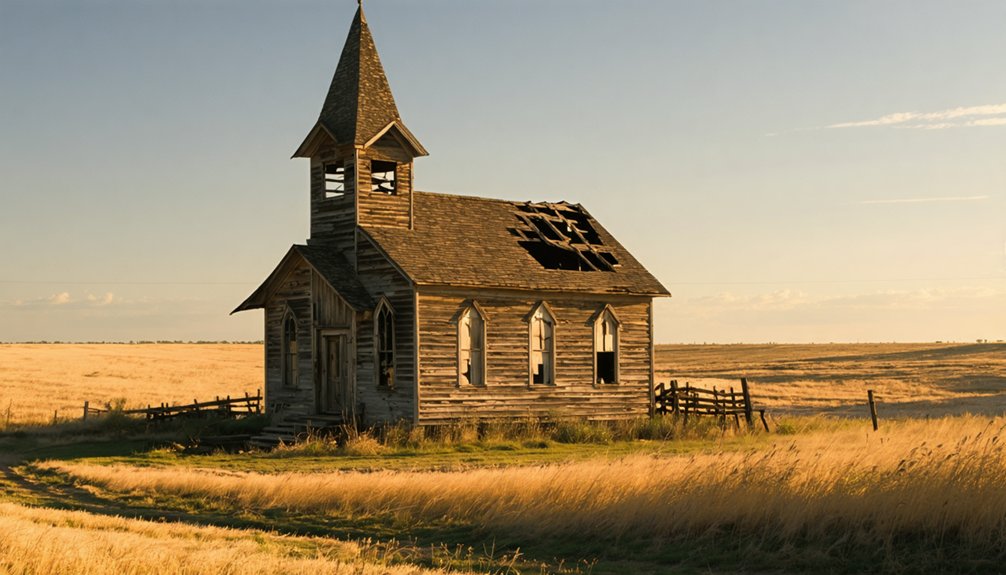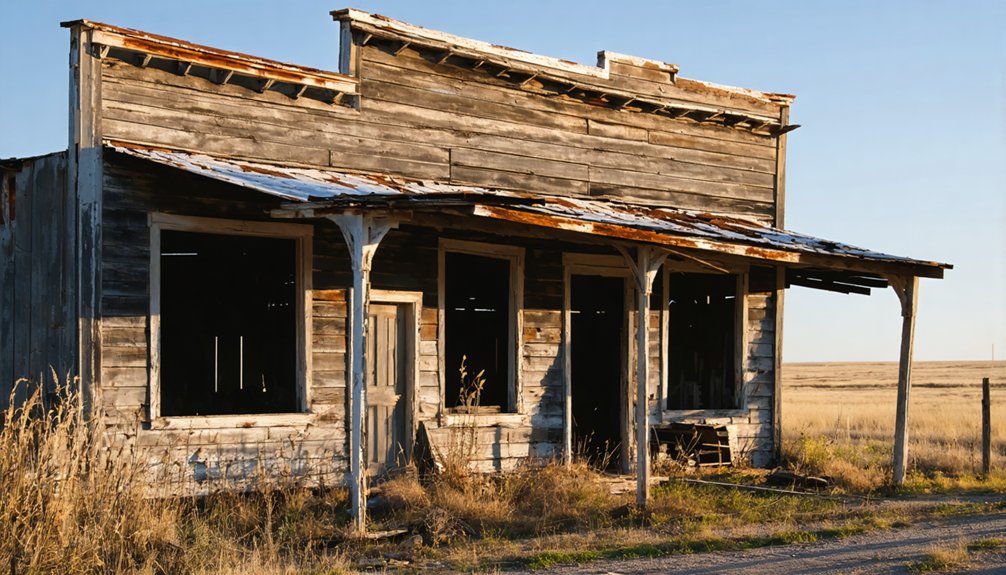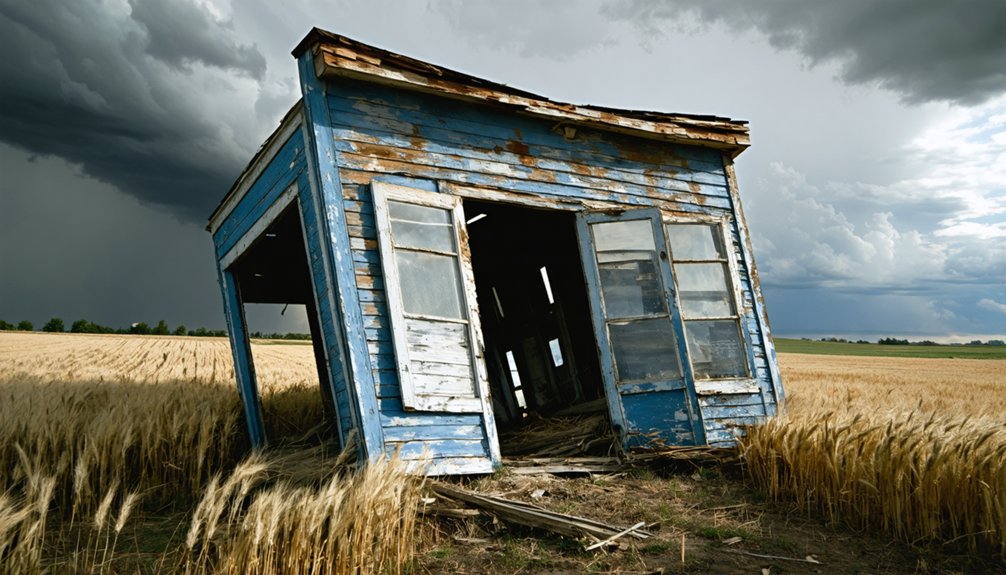You’ll discover Besant nestled in South Dakota’s prairie landscape, where a once-thriving mining and railroad community flourished in the late 1800s. The town grew around the Chicago, Burlington & Quincy Railroad, with its depot serving as a crucial social hub for residents. The bustling main street, lined with mercantiles and boarding houses, ran parallel to the tracks until declining ore yields led to the town’s abandonment. Today’s weathered wooden frames and stone chimneys hold countless untold stories of prairie life.
Key Takeaways
- Besant thrived as a mining and railroad town in South Dakota until declining ore yields led to economic downturn and eventual abandonment.
- The town’s layout followed a grid system with its main street parallel to railroad tracks, optimizing commercial and industrial activities.
- Local architecture utilized wood, stone, and brick materials, with weathered wooden frames and stone chimneys still visible today.
- A haunting chapel and gravesites from the 1919 influenza epidemic remain as silent witnesses to the town’s past.
- The Chicago, Burlington & Quincy Railroad was central to Besant’s development, with the depot serving as a vital social hub.
The Birth of a Prairie Settlement
Before the settlement of Besant emerged on the Dakota prairie, the land held deep significance for Indigenous peoples, particularly the Dakota and Sioux nations who maintained ancestral ties to the region.
The Dakota prairie echoes with ancient footsteps, a sacred homeland where Indigenous peoples lived in harmony with the land for generations.
The Woodland People hunted bison, deer, and antelope across these grasslands while fishing the abundant streams.
You’ll find evidence of their sophisticated Indigenous practices through discovered bone tools, flood plain gardens, and wattle-and-daub structures that once dotted the landscape.
French and British fur traders ventured through these territories, establishing vital trading networks with Indigenous communities.
As federal policies shifted in the 1860s, you’d witness dramatic changes through the Homestead Act‘s promise of 160-acre claims.
Settlement challenges faced by newcomers included adapting to prairie conditions and establishing farms on land that Indigenous peoples had stewarded for generations.
The creation of Dakota Territory in 1861 accelerated this transformation, as settlers responded to government incentives by building homes and breaking prairie soil, forever altering the region’s character.
Life Along the Railroad Lines
You’d find railroad workers in Besant maintaining a demanding schedule of track repairs, signal operations, and train dispatching from dawn to dusk.
The town’s train depot served as more than just a transit point – it was a vibrant social hub where residents gathered to exchange news, collect mail, and welcome visitors. Similar to other historic railroads like the Black Hills Central, the depot was crucial to connecting communities.
Beyond passenger services, the depot handled essential freight operations, connecting local farmers and merchants to broader markets while bringing in supplies vital for the community’s survival. Similar to how speculators and investors seized opportunities in other Dakota towns, many businesspeople relocated their operations to be near the promising railroad lines.
Railroad Worker Daily Life
Life along the railroad lines during the late 19th century demanded extraordinary physical endurance, as workers routinely faced 12-hour days and dangerous conditions while earning roughly $2.50 per day.
You’d have witnessed the railroad hardships firsthand – brakemen leaping between moving cars to operate manual brakes, flagmen standing for hours in bitter cold, and workers running on uneven ballast to throw switches.
These labor struggles often stretched into 16 or 20-hour shifts without rest. Like modern web protection systems, workers had to maintain continuous monitoring to prevent disruptions to rail operations.
Communication relied on precise hand signals between crew members, with life-or-death decisions hanging on split-second timing.
Beyond the physical toll, you’d have battled frostbite and hypothermia during harsh winters. Railroad brakemen worked in open, unprotected cabins that provided minimal shelter from extreme weather.
Despite powering America’s westward expansion, these workers shared few of the economic rewards, leading to the massive railroad strike of 1877.
Train Depot Social Hub
Train depots served as vibrant social hubs that transcended their basic transportation function, becoming the beating hearts of frontier communities.
You’d find separate waiting rooms for ladies and gentlemen, where social interactions flourished as travelers and locals exchanged news and conducted daily business. These spaces, like the brick and stucco building in Beresford, provided distinct areas where passengers could comfortably await their trains. The depot’s strategic location near downtown meant you could easily connect with others while managing your travel needs at the ticket office or sending urgent telegrams.
During wartime, you’d witness these social spaces transform into essential service centers, with community organizations running canteens for troops passing through. In Aberdeen, the Red Cross canteen became famous for serving soldiers their signature pheasant sandwiches.
Depot gatherings fostered a sense of solidarity and connection, as residents shared newspapers, collected mail, and participated in community events. The depot’s role as a social nucleus helped shape the town’s identity and survival.
Freight and Passenger Services
South Dakota’s rail networks revolutionized frontier life by establishing essential freight and passenger corridors through towns like Besant in the late 19th century.
You’d find trains carrying crucial supplies like grain, livestock, fuel, and building materials that sustained the town’s growth despite harsh environmental conditions. The reliable freight transportation helped local farmers and merchants connect to broader markets at competitive rates. Rail freight services remained the dominant mode of transportation throughout the region.
The passenger mobility transformed social connections and settlement patterns. You could witness soldiers moving through during World War II, with Red Cross canteens offering comfort at station stops.
The depot served as more than just a transit point – it became a community hub where people gathered, commerce flourished, and information flowed. Rail service shaped everything from street layouts to economic opportunities, employing a significant portion of local residents. The town followed a classic T-shape town layout with its commercial avenue running perpendicular to the railroad tracks.
Economic Rise and Fall
Like many Black Hills settlements, Besant’s economic trajectory hinged on the promise of mineral wealth, with hard rock mining serving as the foundation of its early prosperity.
During the mining boom, you’d have seen a bustling town with multiple railroad lines, processing mills, and cyanide vats. When ore yields declined, Besant’s economy quickly unraveled, leading to a devastating economic decline that affected every aspect of community life.
Besant’s thriving mining operations and infrastructure crumbled rapidly once the precious ore began running dry, devastating the entire community.
- Heavy investment in mining infrastructure created jobs and attracted businesses
- Railroad connections facilitated ore shipment and supported population growth
- Banks, mercantiles, and boarding houses flourished during peak years
- Environmental challenges and economic shocks weakened the town’s resilience
- Loss of rail service and mining operations triggered mass exodus and business closures
Architectural Legacy and Remnants

As you explore Besant’s architectural remains, you’ll notice the pragmatic use of locally-sourced materials like wood, stone, and brick that defined frontier construction methods.
The buildings’ rectangular layouts and sturdy foundations demonstrate how settlers adapted structural designs to withstand harsh Dakota winters and summer storms.
The weathered wooden frames of former homes and businesses, along with their surviving stone chimneys and cellars, reveal how these prairie structures have endured decades of exposure to the elements.
Prairie Building Materials Used
When exploring Besant’s architectural remains, you’ll find the town’s buildings primarily utilized wood-frame construction, thanks to the abundant timber resources available during its settlement period.
The practical choice of materials reflected both necessity and availability, with local stone serving as foundations and chimneys in many structures.
- Weathered wooden frames stand as silent sentinels, their gray-black patina telling tales of prairie storms
- Stone foundations and brick elements remain most visible, outlasting their wooden counterparts
- Metal components, especially in railroad-related structures, show the town’s transport connections
- Agricultural storage buildings and grain silos stand as symbols of the farming community
- Salvaged materials reveal the town’s decline, with many structures showing signs of reconstruction using aged materials
Structural Design and Features
Besant’s structural design reveals a thoughtfully planned railroad town from the early 20th century.
You’ll find its urban planning centered on a compact grid system, with Main Street running parallel to the railroad tracks. This layout maximized efficiency for both commerce and industry, while residential areas featured practical wood-frame houses arranged in neat rows.
The town’s architectural simplicity reflected its industrial purpose, with specialized structures like sawmills and workshops built for functionality rather than aesthetics. Public buildings, including the chapel and schoolhouse, showcased rectangular plans with pitched roofs.
Today, you can still trace Besant’s original layout through surviving foundations, the converted rail bed, and remnants of the chapel. These architectural elements tell the story of a community shaped by railroad commerce and logging operations.
Weathered Against Dakota Elements
Throughout decades of exposure to Dakota’s unrelenting climate, the architectural remnants of Besant tell a compelling story of structural resilience and inevitable decay.
You’ll find the harsh climate impact evident in every weathered surface and crumbling wall. Wind-worn wood structures display deep erosion patterns, while stone foundations bear witness to countless freeze-thaw cycles. Material deterioration continues relentlessly as nature reclaims these historic spaces.
- Original building footprints remain visible through surviving foundation stones
- Metal artifacts, from rusted hinges to old farm implements, lie scattered among the ruins
- Brick chimneys stand as solitary sentinels, defying decades of prairie winds
- Tree roots now intertwine with cellar walls, creating an unintended sculpture of time
- Historic infrastructure traces, including old railbed cuts, still mark the landscape
Daily Life in Early Besant

Life in early Besant revolved around the Chicago, Burlington & Quincy Railroad, which shaped both the town’s economy and its daily rhythms. You’d find railroad workers hurrying to their shifts while their families tended to wooden homes near the tracks.
The post office and general store served as bustling social hubs where you’d catch up on local news and stock up on supplies brought in by train.
Community gatherings at the local church or meeting hall helped break up the monotony of work life. You’d join your neighbors for seasonal celebrations, baseball games, and visiting entertainers.
Neighbors gathered regularly to share joys and entertainment, creating vibrant community life amid the daily grind of railroad work.
Despite harsh winters and basic living conditions, you’d make do with well water, wood-heated homes, and careful rationing of supplies. The railroad’s presence meant you were never completely cut off from the outside world.
Notable Stories and Local Legends
While countless ghost towns dot South Dakota’s landscape, Besant’s legends paint an especially haunting portrait of tragedy and lost dreams.
You’ll find ghostly apparitions and tragic tales woven throughout the town’s history, from the somber gravesite marking victims of the 1919 influenza epidemic to the haunting chapel that stands as a silent witness to the past.
The town’s decline mirrors other South Dakota communities where railroad changes and economic collapse led to mass exodus.
- Eerie sounds and unexplained phenomena near the abandoned town site
- Tales of protective spirits linked to fallen soldiers and war memorials
- Stories of abruptly abandoned homes and mysterious lost fortunes
- Reports of unsettling experiences around decaying railroad tracks
- Legends of devastating floods that hastened the town’s demise
Exploring Besant Today

Despite its historical significance in Lawrence County, Besant stands as one of South Dakota’s most elusive ghost towns today.
You’ll find ghost town exploration challenging here, as nature has reclaimed most visible traces of the former settlement. The site’s exact location remains difficult to pinpoint, with no marked ruins or standing structures to guide your way.
If you’re determined to visit, you’ll need to rely on historical archives and old maps while maneuvering through the rugged Black Hills terrain. Local historical societies offer valuable research materials to aid your search.
Consider timing your visit during favorable weather conditions, as the Black Hills’ harsh winters and dry summers can impact accessibility. Remember that while physical remnants may be scarce, Besant’s story lives on through documented records of the region’s mining and logging heritage.
Frequently Asked Questions
What Wildlife Species Can Commonly Be Found Around Besant Today?
You’ll spot white-tailed deer and coyotes in wildlife habitats near prairies, while bird species like bald eagles and pheasants soar overhead. Prairie dogs, beavers, and seasonal migrants enrich local ecosystems.
Are There Any Documented Paranormal Activities or Ghost Sightings in Besant?
While you might expect ghostly encounters in an abandoned town, there’s no documented spectral history or verified paranormal activity in the area. Research and historical records don’t support claims of supernatural occurrences.
Can Visitors Camp or Park RVS Near the Ghost Town?
You can camp at designated sites nearby, following local camping regulations. For RV accessibility, use established campgrounds in Black Hills National Forest or opt for dispersed camping within 300 feet of approved roads.
What Is the Closest Modern Town With Amenities to Besant?
You’ll find Rapid City offers the most extensive modern amenities near Besant, with hotels, restaurants, and nearby attractions. It’s your best base for exploring the area’s ghost town sites.
Are Metal Detectors Allowed for Treasure Hunting in Besant?
While you might be keen to explore, you’ll need a written permit from South Dakota Game, Fish, and Parks first. Metal detecting regulations require authorization, and you can’t dig deeper than 6 inches.
References
- https://www.curbsideclassic.com/uncategorized/the-ghosts-of-witten/
- https://www.sdpb.org/rural-life-and-history/2023-08-21/some-black-hills-ghost-towns-and-their-origins
- https://www.powderhouselodge.com/black-hills-attractions/fun-attractions/ghost-towns-of-western-south-dakota/
- https://www.sdhspress.com/journal/south-dakota-history-2-2/some-black-hills-ghost-towns-and-their-origins/vol-02-no-2-some-black-hills-ghost-towns-and-their-origins.pdf
- https://www.youtube.com/watch?v=_0WNYsFLSLA
- https://www.southdakotamagazine.com/1880-town
- https://en.wikipedia.org/wiki/List_of_ghost_towns_in_South_Dakota
- https://www.onlyinyourstate.com/experiences/south-dakota/capa-ghost-town-sd
- https://www.sdhspress.com/journal/south-dakota-history-13-1/prehistoric-and-early-historic-farming-and-settlement-patterns/vol-13-no-1-and-no-2-prehistoric-and-early-historic-farming-and-settlement-patterns.pdf
- https://www.sdglaciallakes.com/about-us/about-the-region/history/



